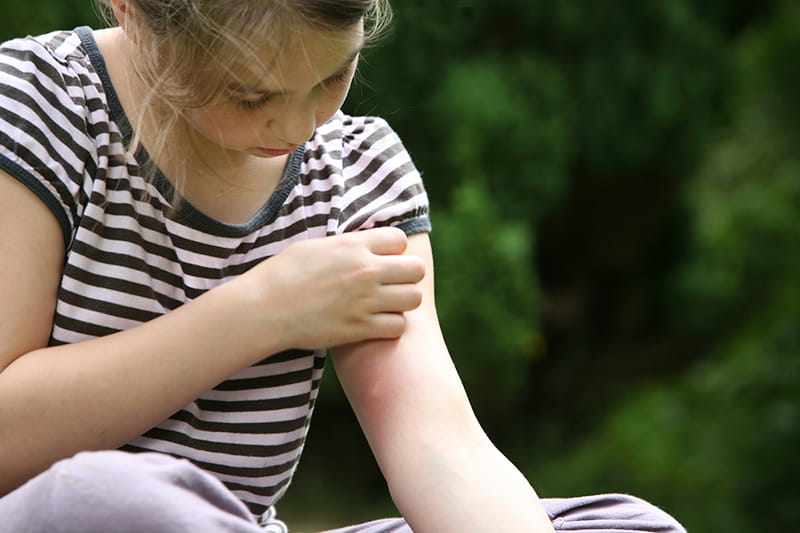Spend enough time outside this summer, and you'll get bit, even stung. Luckily, you can clear up most common insect issues on your own.
Posted
by Featured Provider April Kolb on Thursday, June 20, 2019
 It's a sight as common as a summer sunburn. Red bumps and welts that dot your skin after some outdoor fun. They itch. They swell. They itch some more.
It's a sight as common as a summer sunburn. Red bumps and welts that dot your skin after some outdoor fun. They itch. They swell. They itch some more.
Most bug bites and stings stop there. Outside the itchiness, they're harmless. And you can usually find relief with over-the-counter ointments.
"Usually, it's just a local reaction. It's just a red welt and you can't really distinguish what bit you based off what your bite looks like," says April Kolb, DO, Family Medicine physician at The Iowa Clinic in Waukee. "You can get topical Benadryl, hydrocortisone cream or oral antihistamines to stop the itching. The steroid cream will help a lot."
Stings are sometimes more painful. "You can still use the hydrocortisone cream," Dr. Kolb says. "If you wanted to take some ibuprofen or acetaminophen, that could help with the symptoms too."
Stings and bites are nothing to worry about — unless they cause an allergic reaction.
It's more common to be afraid of wasp, hornet and bee stings than to be allergic to them. Enough bites from mosquitoes and other biting insects like chiggers, gnats and ants can send your immune system into overdrive too.
"Often times, people just don't know what they got bit by or stung by. A general rule of thumb, regardless of what bites you, is if you're experiencing anything beyond just a local reaction, that's concerning," Dr. Kolb says. "With stings, particularly bee stings, you worry about if you're going to have an allergic reaction to that. You can have an allergic reaction to the other bites too, but it's far less common."
Signs of an Allergic Reaction to Bug Bites or Stings
Swelling, redness and even a little pain is all normal — as long as it's confined to the site of your bite or sting. Even if the red welt swells to an unusually large size, it's still normal.
If you have these symptoms, it's not normal — it's an allergic reaction:
- Shortness of breath
- Tightness in the chest
- Wheezing
- Numbness or tingling of your lips or throat
- Cramping, nausea, vomiting or diarrhea
- Feeling that your throat is closing or difficulty swallowing
"If you feel like you're having a severe allergic reaction, that's an emergency. You need to go to the ER," Dr. Kolb says. "If you suffer from multiple stings or bites, it would probably still be good to get checked out by your primary care provider."
Signs of an Infected Bug Bite
"Another thing that I see a lot is a secondary bacterial infection called cellulitis. If you develop any type of redness or swelling beyond just the local welt, then you might have a secondary bacterial infection of the skin and soft tissue," Dr. Kolb says.
With cellulitis, the redness spreads but the bite itself usually turns black. It can be warm and tender to the touch. You need to go to the doctor to get antibiotics to fight the infection.
Some spider and tick bites can cause serious problems.
They get lumped into the "bug" category, but spiders and ticks aren't insects. They're arachnids. While arachnophobia is one of the most common fears, you shouldn't be afraid of getting bitten.
All spiders are venomous — it's how they catch their prey. Yet most are harmless to humans. There are only two types of spiders you need to be wary of, and neither are common in Iowa. Disease-carrying ticks are of greater concern.
Black Widow Spider Bites
Black widows are native to Iowa but are not very common. They avoid light, so you might find them under a log or wood pile. Black widows aren't aggressive and only bite humans when they feel threatened.
"A black widow bite usually causes things like severe muscle cramps and spasms. It's rarely life-threatening but definitely would be a reason to seek emergency care," Dr. Kolb says.
Brown Recluse Spider Bites
Brown recluse spiders are even less common in Iowa. They're more likely found in the south central part of the United States. The Des Moines area falls at the northernmost tip of their range. And because of the climate, brown recluse spiders could only be found indoors where it's warm and dry, hiding in cracks between appliances, under boxes or behind shelves.
Like black widows, brown recluse spiders only bite when threatened and can't escape. Their bites are often painless but may give you a slight stinging sensation. That turns into a burning sensation several hours later. The spider bite will blister and can cause necrosis, or the death of the skin, surrounding the area, which is another reason to seek emergency treatment.
Tick Bites
"We have to worry about tick bites particularly because, in this part of the United States, they can carry Lyme disease," says Dr. Kolb.
Deer ticks are the carriers. They're commonly found in the oak forests around Iowa and are most likely to spread Lyme disease in April, May and June. If you develop a bullseye-like rash a few days or even a month after a tick bite, that's a sign of Lyme disease and you need to see your primary care provider immediately for treatment.
Protect yourself outdoors to prevent insect bites.
Bug sprays repel more than just mosquitoes. Depending on the bug repellent, it can help prevent fly, gnat and chigger bites too. For best protection, use a bug repellent with 10 to 30 percent DEET to deter insects.
Since spiders aren't insects, avoiding them altogether is the only way to prevent bites. You can repel ticks, however. Soaking your clothes in a permethrin product like Nix or Rid before a hike, camping trip or other extended time in the woods can help repel ticks.
"Use insect repellent with DEET. Wear long pants and long sleeves, socks and hats. Avoid areas where you know bugs and ticks are going to be. Those are the main things you need to do," says Dr. Kolb.
Meet This Featured Provider

Learn More About:
Family Medicine,
Primary Care,
Women's Center,
Men's Center
April Kolb, DO joined The Iowa Clinic because of its reputation for excellent patient care. She comes to the clinic from the Family Medicine Residency program at Broadlawns in Des Moines.
Dr. Kolb chose Family Medicine because of the ability to care for patients of all ages. She conside... Read More
Schedule Now
Other Family Medicine
Tags
- family medicine